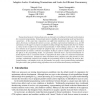628 search results - page 73 / 126 » Tying Memory Management to Parallel Programming Models |
IPPS
2006
IEEE
15 years 6 months ago
2006
IEEE
Dynamically allocating computing nodes to parallel applications is a promising technique for improving the utilization of cluster resources. We introduce the concept of dynamic ef...
159
Voted
HPCA
2002
IEEE
16 years 27 days ago
2002
IEEE
Power dissipation has become one of the most critical factors for the continued development of both high-end and low-end computer systems. The successful design and evaluation of ...
98
Voted
SC
2005
ACM
15 years 6 months ago
2005
ACM
The memory consistency model in parallel programming controls the order in which operations performed by one thread may be observed by another. Language designers have been reluct...
126
click to vote
IEEEPACT
2009
IEEE
14 years 10 months ago
2009
IEEE
Transactional memory is being advanced as an alternative to traditional lock-based synchronization for concurrent programming. Transactional memory simplifies the programming mode...
107
click to vote
IWOMP
2009
Springer
15 years 5 months ago
2009
Springer
Abstract. Exploiting the full computational power of current hierarchical multiprocessor machines requires a very careful distribution of threads and data among the underlying non-...

